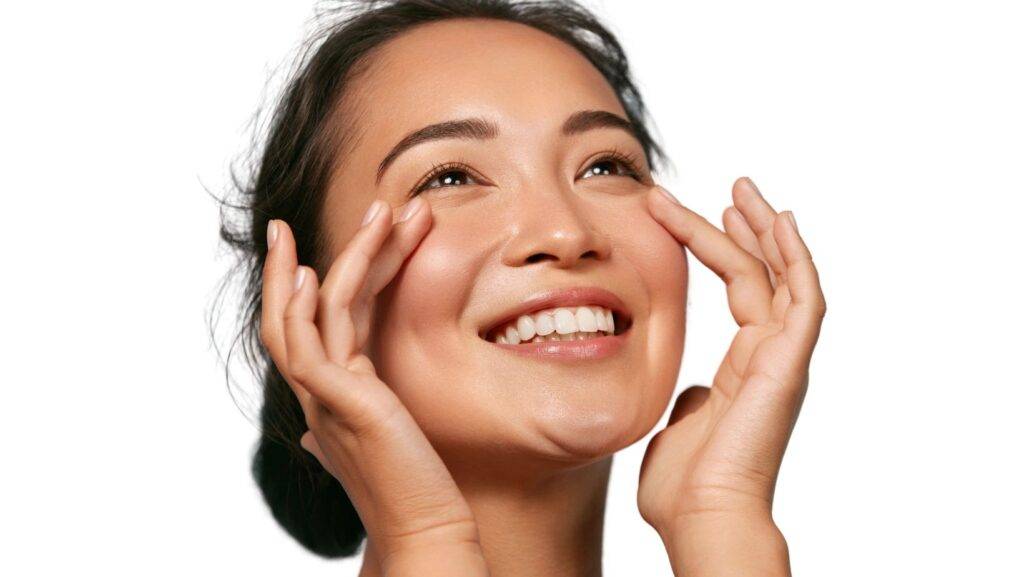
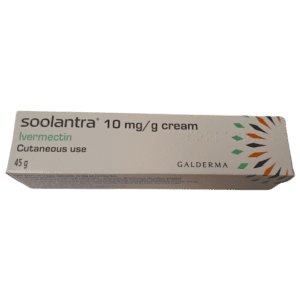
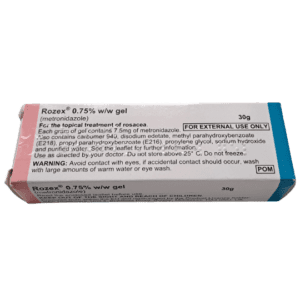
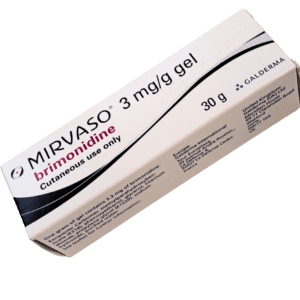
Rosacea is a common skin condition that primarily affects the face, causing redness across the nose, cheeks, chin, and forehead. This redness can be intermittent or persistent. Alongside redness, Rosacea can lead to skin discomfort such as burning or stinging sensations, the development of pimples, dry skin, facial swelling, and even skin thickening.
In some cases, individuals may also experience eye-related issues. Globally, around 415 million people are affected by rosacea. While there is no outright cure, the symptoms can be effectively managed and treated.
Rosacea presents itself in four main types:
Facial Redness and Flushing with Visible Blood Vessels: This type often accompanies dry, sensitive, or swollen skin.
Acne-like Breakouts: These outbreaks may come and go, potentially causing oily skin and a sensation of burning.
Skin Thickening: The skin might become thicker and rougher, particularly around the nose, chin, cheeks, forehead, and ears.
Rosacea Affecting the Eyes: Eye-related symptoms may include itching, burning, light sensitivity, redness, watery eyes, and a feeling akin to having sand in the eyes.
The precise cause of rosacea remains unclear. However, research suggests possible links to factors like microscopic skin mites, facial nerves, blood vessels, immune system responses, and even certain underlying health conditions.
Certain factors can increase the likelihood of developing rosacea, such as:
Fair Skin: People with fair skin are more prone to rosacea.
Blood Vessel Abnormalities: Issues with blood vessels might contribute to the condition.
Skin Mites (Demodex): The presence of certain mites on the skin may play a role.
Bacteria (Helicobacter Pylori): Some bacterial infections could be associated with rosacea.
Family History: A family history of rosacea can raise the risk.
For many individuals, specific foods can exacerbate symptoms. Keeping a food diary can help pinpoint these triggers. Some common triggers include:
Hot Drinks
Caffeine
Dairy Products
Alcohol
Spicy Foods
Citrus Fruits
Tomatoes
A range of signs and symptoms could indicate rosacea, varying from primary to additional indications. Initial signs include:
Facial Flushing: Redness on the nose, cheeks, forehead, and chin that can persist over time.
Visible Blood Vessels: Thin red lines that become noticeable on the skin.
Pimples or Red Bumps: Resembling acne, these bumps might cause stinging or burning and typically appear in the center of the face.
In individuals with darker skin tones, these symptoms can be harder to detect initially. Additional possible symptoms involve:
Eye Irritation
Dry Skin Sensation
Facial Swelling
Elevated Red Patches
Stinging and Burning Sensations
Skin Thickening, Often Around the Nose
Rosacea manifests as persistent redness on the face that doesn’t fade. This may be accompanied by pimple-like bumps similar to acne or small, visible blood vessels. Over time, the affected person might appear as if they are frequently blushing.
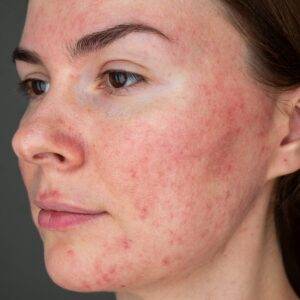
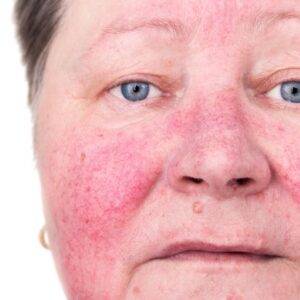
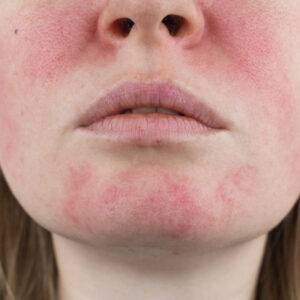
Rosacea cream encompasses a variety of specialized creams and gels that your healthcare provider might recommend for addressing mild to moderate rosacea. These creams are applied as directed to the affected skin area.
Rosacea cream helps diminish the redness resulting from rosacea by narrowing blood vessels. This action aids in alleviating discomfort, such as skin irritation.
Mirvaso gel is designed to temporarily reduce rosacea-related redness. It’s applied once daily to the affected region. Use a small amount, about the size of a pea, and spread it evenly across the face, including the chin, cheeks, forehead, and nose. Avoid contact with lips, inside the nose, and eyes. Allow the gel to dry before applying makeup. Mirvaso contains brimonidine, which constricts blood vessels and reduces redness and swelling, though some users might experience increased redness initially. Start with a small amount to test your reaction. The effects last a few hours, and redness may return afterward.
Soolantra is suitable if you have rosacea-related acne or inflammatory lesions. This cream contains anti-inflammatory components effective in reducing symptoms associated with rosacea acne. It achieves substantial improvement or near-clearance of symptoms in about 80% of individuals with moderate to severe symptoms after three months of use. The active anti-inflammatory ingredient is ivermectin. Additionally, it could help eliminate skin mites (demodex). Soolantra can be used when rosacea recurs.
Metronidazole gel manages inflammation and infection in the skin, with visible results typically seen within four weeks. It’s effective for mild to moderate cases. After washing your face, apply a thin layer to the affected area and gently massage it in. Rosacea responds gradually to medication, so consistent use based on your doctor’s recommendation is essential.
Dermalex is a common non-prescription option without antibiotics or medications. It eases rosacea flare-ups, strengthens the skin, and soothes inflammation. This steroid-free cream is approved for long-term use.
The ideal rosacea cream varies based on your specific type of rosacea, its severity, and your skin type. If you’re new to rosacea cream or uncertain about which product suits you best, our doctors can guide you toward the appropriate treatment.



Using Rosacea Cream Properly:
Applying the Cream or Gel: To use rosacea cream effectively, follow these steps:
Direct Application: Apply the cream or gel directly onto the areas of your skin affected by rosacea.
Right Amount: Take a small amount of the cream or gel, similar to the size of a pea. This is a good starting point, but you can adjust based on how much coverage you need.
Even Coverage: Spread the cream or gel evenly over the affected areas. Make sure to cover each area—like your nose, cheeks, chin, and forehead—with its own small amount.
Avoid Delicate Areas: Be careful not to apply the cream or gel to sensitive areas like your lips, eyes, or inside your nose. These areas need special care.
Clean Hands: After applying the cream or gel, remember to wash your hands thoroughly to remove any residue.
Frequency of Use:
How often you use rosacea cream depends on a few factors:
Rosacea Type: The type of rosacea you have plays a role in how often you should use the cream.
Prescribed Cream: Different creams have different instructions, so follow what your doctor recommended.
Symptom Severity: If your symptoms are more severe, you might need to use the cream more frequently.
Most often, you’ll use the cream once a day, but in some cases, it could be more frequent. The instructions given by your doctor are your best guide.
Seeing Results:
You’re likely to start noticing improvements within about 4 weeks of consistent use. But don’t worry if it takes a bit longer; sometimes it can take up to 8 weeks for noticeable changes. If you’re not seeing any improvement after 8 weeks, it’s a good idea to talk to your doctor.
Proper Application to Your Skin:
Follow these steps for applying rosacea cream to your skin:
Right Amount: Start with a small, pea-sized amount of rosacea cream.
Gentle Application: Apply the cream gently to your face, ensuring even coverage. But avoid your eyes and lips.
Hands-On: After you’re done applying, wash your hands thoroughly to clean off any remaining cream.
Getting Rosacea Cream:
Where to Find Rosacea Cream: If you’re looking for rosacea cream, you have a few options:
Over the Counter: Non-prescription rosacea creams can be bought directly from your local pharmacy without a prescription. Examples include Dermalex.
Prescription Medications: For medicines like Metronidazole, Mirvaso, and Soolantra, you’ll need a prescription. You can obtain these from Online Chemist Private Doctor.
Prescription Rosacea Cream Online:
Yes, you can buy prescription rosacea cream online in a safe and legal manner. Online Chemist Private Doctor is a reputable source for this. Here’s how the process works:
Online Questionnaire: Complete a brief online health questionnaire, providing information about your medical history.
Doctor’s Review: One of our clinicians will review your responses to determine the most suitable rosacea treatment for you.
Prescription Issued: If it’s deemed safe and appropriate, a prescription will be issued for the appropriate rosacea cream.
Delivery: You can choose to have your prescribed treatment delivered to your chosen address.
Customer Support: Our UK-based customer support team is available to answer any queries or provide information about the medication you’ve received.



Variability in Side Effects: Side effects of rosacea cream can differ from person to person, and they can also vary based on the specific cream you’re using, as different creams contain different ingredients. While some individuals may experience no side effects, others might encounter one or more.
Common Side Effects: The following are among the most frequently reported side effects of rosacea cream:
Watery Eyes: Some individuals might experience increased tearing or watering of the eyes.
Skin Peeling: Peeling of the skin is another common side effect that can occur with certain rosacea creams.
Dry Skin: Skin dryness is a possible side effect, leading to a feeling of tightness or flakiness.
Lightening of Treated Skin: In some cases, the skin where the cream is applied might become lighter in color.
Skin Redness: Redness of the skin can occur, potentially as a reaction to the treatment.
Burning Sensation: A burning sensation on the skin, particularly after applying the cream, is another reported side effect.
Sunlight Sensitivity: Some rosacea creams might make your skin more sensitive to sunlight, potentially leading to increased sunburn risk.
To minimize the impact of rosacea symptoms, consider the following steps:
Daily Sunscreen: Protect your face daily with sunscreen of SPF30 or higher.
Sun Hat: Wear a hat when exposed to the sun for added protection.
Identify Triggers: Recognize your triggers and avoid them to lower the risk of flare-ups.
Gentle Care: Handle your skin with care; refrain from excessive touching of your face.
Regular Moisturizing: If your skin tends to be dry, moisturize regularly with a non-greasy moisturizer.
Avoid Alcohol-Containing Products:
Green-Toned, Matte Makeup: Use powder makeup with a green tone and matte finish to help conceal redness if desired.
Spotting the Initial Signs: If you’re concerned about rosacea, keep an eye out for these early indicators:
Redness: Blushing that comes and goes across your nose, cheeks, forehead, chin, neck, and chest. Your skin might feel warm, hot, or even painful.
Burning or Stinging: Sensations of burning or stinging when using water or skincare products.
Variations in Skin Tone: Note that on brown or black skin, the redness may be less apparent.
As rosacea advances, the following changes may occur:
Constant Redness: Skin on your cheeks, nose, and forehead might become persistently red.
Broken Blood Vessels: Tiny broken blood vessels may surface on your skin, which won’t fade away on their own.
Small Bumps: Small pink or red bumps could appear on your face, sometimes containing a yellowish fluid.
Other Possible Symptoms: Beyond these signs, other symptoms may include:
Dry Skin: Skin becoming dry.
Swelling: Swelling, especially around the eyes.
Patches on Skin: Yellow-orange patches appear on the skin.
Sore Eyelids: Eyelids feeling sore or developing crusts around the base of eyelashes (a condition known as blepharitis).
Thickened Skin: Thickened skin, often on the nose, usually appears after several years.
Understanding What Makes Symptoms Worse: Although the exact cause of rosacea isn’t fully understood, certain factors can exacerbate its symptoms.
Frequent Triggers for Rosacea: Here are some common triggers that can worsen rosacea symptoms:
Alcohol: Consumption of alcoholic beverages can lead to symptom flare-ups.
Spicy Foods: Foods with intense spices might trigger or intensify rosacea symptoms.
Hot Drinks: Beverages like hot tea or coffee can contribute to symptom aggravation.
Sunlight Exposure: Exposure to sunlight, especially without protection, can worsen rosacea symptoms.
Extreme Temperatures: Both hot and cold temperatures can trigger flare-ups.
Aerobic Exercise: Activities involving vigorous aerobic exercise, such as running, might exacerbate symptoms.
Stress: Emotional stress can be linked to worsening of rosacea symptoms.
Taking Care of Symptoms: Remember, rosacea isn’t a result of poor hygiene, and it’s not contagious. However, there are actions you can take to alleviate its impact.
Identify and Manage Triggers: If you’re aware that certain triggers like alcohol or spicy foods worsen your symptoms, consider reducing or avoiding them when possible.
Do’s:
Sun Protection: Apply a high SPF sunscreen with at least SPF 30 daily to shield your skin.
Climate Considerations: Whenever feasible, avoid excessive heat, sunlight, or humid conditions.
Cold Weather Protection: In chilly weather, consider covering your face to prevent excessive exposure.
Gentle Skincare: Opt for gentle skincare products designed for sensitive skin.
Blepharitis Care: If you have blepharitis, clean your eyelids at least once a day.
Stress Management: Implement strategies to manage stress, as stress can affect rosacea symptoms.
Don’ts:
Alcohol Avoidance: Refrain from alcohol consumption, as it can worsen symptoms.
Hot Drinks: Steer clear of hot beverages, as they can trigger or intensify symptoms.
Spicy Food: Avoid consuming spicy foods, which might contribute to symptom flare-ups.
Moderate Exercise: While exercise is beneficial, avoid excessive aerobic activities like running, which can exacerbate symptoms.
It’s crucial to remember that rosacea management varies for each person. If you’re uncertain about any aspect of your treatment plan, consult your healthcare provider for personalized guidance. Your efforts to minimize triggers and care for your skin can contribute to a more comfortable experience with rosacea.



Complete consultation for your selected condition and order your medication.
Please answer the health questionnaire honestly, this will ensure that the medication you are requesting is right for you.
The UK registered prescriber will review your questionnaire and approve your order. In some cases, the prescriber may specify a preferred treatment.
Your treatment will be sent directly from our NHS online pharmacy, Online Chemist based in Norfolk.
The General Pharmaceutical Council (GPhC) and other UK health organisations have produced a handy guide to help people going online for medicines or treatment.
Read the guideline here
If you have a medical emergency do not use this service.
Please contact your own GP, visit Accident and Emergency or call 999 or 111 immediately.
Don’t simply rely on our claims, become part of the delighted community of thousands of customers who are experiencing the remarkable benefits!

Online Chemist
82 Middleton Road
Gorleston
Great Yarmouth
Norfolk, NR31 7AH
Phone: 01493 600610
Email: info@onlinechemistuk.net
Superintendent Pharmacist:
Obaidullah Zaman
BPharm, MPharm, PGDip (Pharmacy), MRPharmS, IP
GPhC Reg. Number: 2083409
Pharmacy Premises GPhC Reg. Number: 9011159
Monday 09:00 – 17:00
Tuesday 09:00 – 17:00
Wednesday 09:00 – 17:00
Thursday 09:00 – 17:00
Friday 09:00 – 17:00
Saturday Closed
Sunday Closed
Click here for driving directions
OnlineChemist is a trading name of Nomaz Limited.
Registered in England – 11349276.
© 2025 All rights reserved.